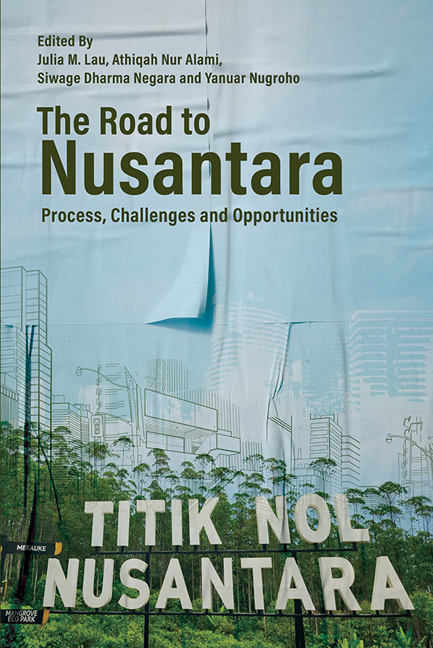Book contents
- Frontmatter
- Contents
- List of Figures
- List of Tables
- Foreword
- Foreword
- The Contributors
- Glossary
- Introduction: The Road to Nusantara—Process, Challenges and Opportunities
- PART I PROCESSES AND PATHWAYS TOWARDS NUSANTARA
- PART II CHALLENGES IN DEVELOPING NUSANTARA
- PART III OPPORTUNITIES FOR NUSANTARA
- Conclusion: Shaping Nusantara
- Index
5 - Addressing the Challenges in Developing Nusantara: The Roles of Spatial Planning
Published online by Cambridge University Press: 01 March 2024
- Frontmatter
- Contents
- List of Figures
- List of Tables
- Foreword
- Foreword
- The Contributors
- Glossary
- Introduction: The Road to Nusantara—Process, Challenges and Opportunities
- PART I PROCESSES AND PATHWAYS TOWARDS NUSANTARA
- PART II CHALLENGES IN DEVELOPING NUSANTARA
- PART III OPPORTUNITIES FOR NUSANTARA
- Conclusion: Shaping Nusantara
- Index
Summary
INTRODUCTION
The plan to relocate Indonesia's capital city (IKN) has finally come to its realization under President Joko Widodo's leadership. Jakarta claims that Nusantara, the new capital city now under construction, will be one of the most sustainable cities in the world. The term “Forest City” has been emphasized as the designated design slogan to accentuate an integrated human-nature approach, where about 75 per cent of the total landscape will be green open spaces. Walking and public transport will be the main modes of mobility in a city where main attractions and services can be accessed within 10 minutes of travel time for any commuter. Besides creating a sustainable city, the planners’ agenda aims to distribute or more evenly transfer economic and population growth out of Indonesia's main island of Java. The central government aims to create approximately 5 million local jobs by 2045,1 which will potentially attract massive in-migration from Java and other islands to the IKN area.
To successfully develop Nusantara, planners must engage in thorough planning. In the initial stage, the government made the plan to relocate the capital a priority in the National Mid-term Development Plan (RPJMN) 2020–2024. This was followed by the enactment of Decree No. 3 of 2022 on the IKN, which highlighted the cruciality of spatial planning as an instrument to guide the construction of a safe, convenient, productive, and sustainable capital city. The General Spatial Plan for the IKN (Presidential Decree 64/2022) will provide a macro-level reference for urban planning, which marks the inauguration of developing Nusantara. Considering the commencement of this megaproject, this chapter reviews and further discusses the related opportunities and challenges and identifies how spatial planning can play significant roles in Indonesia's urban development.
CONCEPTUAL FRAMEWORK AND METHODOLOGY
This chapter will emphasize the importance of spatial planning as an instrument for development planning in the megaproject of Nusantara. In doing so, the authors observe the social and environmental issues concerned, to provide initial information to identify the potential implications for spatial planning. Separately, the authors initiated a workshop using the Synergistics method3 to observe institutional issues within the planning framework and to identify the potential forward pathways for spatial planning.
- Type
- Chapter
- Information
- The Road to NusantaraProcess, Challenges and Opportunities, pp. 107 - 124Publisher: ISEAS–Yusof Ishak InstitutePrint publication year: 2023

